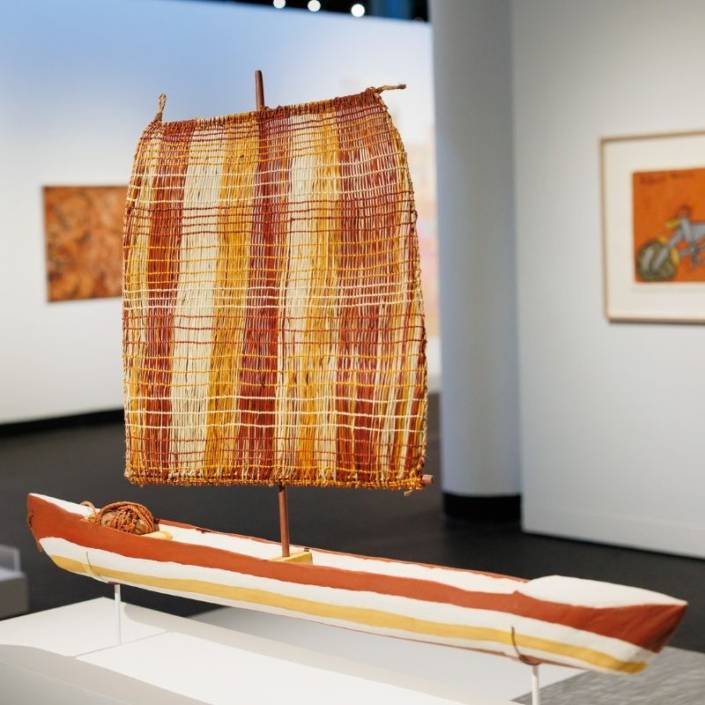SPEAKING VOLUMES
In the UN-declared Year of Indigenous Languages, Darwin Aboriginal Art Fair Foundation executive director Claire Summers speaks to our need to keep linguistic diversity thriving.
Words: Claire Summers
“It is through language that we communicate with the world, define our identity, express our history and culture, learn, defend our human rights and participate in all aspects of society… Through language, people preserve their community’s history, customs and traditions, memory, unique modes of thinking, meaning and expression. They also use it to construct their future. Language is pivotal in the areas of human rights protection, good governance, peace building, reconciliation, and sustainable development.”
(UNESCO, en.iyil2019.org)
The General Assembly of the United Nations proclaimed 2019 the “International Year of Indigenous Languages”. Lead UN agency UNESCO was tasked with pioneering a global awareness campaign throughout the year, highlighting the critical risks that Indigenous languages currently face.
After working in the Aboriginal and Torres Strait Islander arts sector for almost 15 years, it still brings me such great delight to pull out my pocket-sized AIATIS language map of Australia and show people the astounding array of Indigenous languages here. And yet, it bewilders me each time to note how few Australians are aware of this language diversity. I say to people: “Think of Europe… the French, for example, have their own language, cultural practices and connection to the landscape that is completely distinct to that of, say, Germany, Norway or Ukraine. It is the same for our First Nations Peoples here in Australia.” Never fails to be a penny-dropping moment.
There are approximately 7,000 languages worldwide. In Australia alone, there are some 250 distinct Indigenous languages, many of which have dialects of their own (so there are, potentially, hundreds more). In the years since European settlement, more than half of those languages have been lost. Those remaining are the oldest in the world, spanning back more than 60,000 years. And yet now, they face extinction. It’s time that Australians start to rally around this issue. We need to feel the full weight of this devastating loss. Language is the key vehicle to expressing cultural identity; it is the ultimate expression of self-determination.
For those of us who have been lucky enough to travel internationally, we understand how confronting it can be to ask even the most basic questions in a foreign tongue. I remember all too well when a friend of mine tried to order “Bocelli” instead of “bocconcini” in Italy. Meaning is so easily lost in translation, and often there are no equivalent words that can express the power or emotion behind a word or phrase from language to language.
The world has become so incredibly and rapidly clever over the past 100 years or so. We can communicate with earth from the depths of space; we have artificial intelligence that can converse with near-human rationality. And yet we have permitted Indigenous languages to disappear and teeter on the edge of extinction. And when language is lost, so too are ancient histories, stories and cultural knowledge.
For many Aboriginal and Torres Strait Islander people, particularly those who live in remote communities, it is a struggle to explain their thinking, spirituality, stories and cultural practices using English. English may be their third, fourth or fifth language. Art has become one of the most effective ways of explaining and sharing cultural identity. Art was the beginning of language. Across the world, it was used to communicate and send messages long before the written word. Art provides a harmonic expression, intertwining the artist’s stories and ancient histories with the viewers aesthetic and emotional desire to connect with the artwork and understand its significance.
The Darwin Aboriginal Art Fair Foundation has a membership of 70 Aboriginal and Torres Strait Islander Art Centres and Peak Bodies from across Australia. These organisations exist to develop the careers of remote community artists. And in doing so, they are major contributors to the preservation and revitalisation of language and culture. Many Art Centres have initiated language projects that have led to the publication of dictionaries, sound and music recordings, and performances. Every day, they are sitting down with Traditional Owners and artists to record stories and about the art, infusing Indigenous words and phrases into the narrative. This ensures that art buyers have detailed and accurate provenance, and that the story and knowledge embedded in the piece can live forever.
Every Australian can contribute to Indigenous language preservation. Whether it be about learning how to pronounce the names of the Art Centres participating at the 13th Darwin Aboriginal Art Fair, by making an effort to know whose Country you are stepping on to when you’re away on holiday, or by truly respecting and listening to the “Welcome to Country” when you are at an event or conference. If we commit ourselves to this process, then we can all be a part of preserving the knowledge and memory of the past, to create a strong and self-empowered future for Aboriginal and Torres Strait Islander Peoples.
This article was originally published in the 2019 Darwin Aboriginal Art Fair special edition. Read the edition for free below. Darwin Aboriginal Art Fair runs from 9 to 11 august 2019.
Image: Artist Agnes Armstrong of Waringarri Aboriginal Arts. Photo: Sarah Duguid. Courtesy: Waringarri Aboriginal Arts.
ART FAIR SPECIAL EDITIONS
Special editions are free to read and can be viewed on IOS, Android, Kindle and Windows devices.







